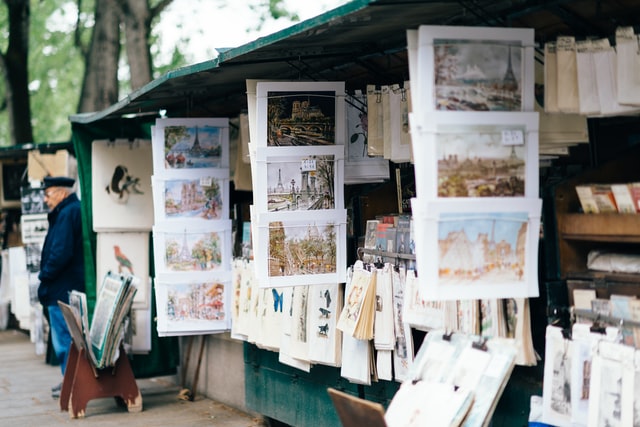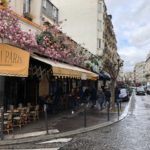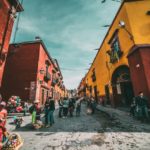Learning to Walk in Paris

I learned how to walk in Paris. I had learned as a child in New York, but the novelty toddled off as milestone crossed into habit. Years passed, one step after another, and walking lost its wonder as it took on purposes outside of itself. Walking, talking, eating—you know something for long enough that you forget you ever learned it.
They say to write what you know. I know that I am not a graceful walker, that I slalom through crowds and empty streets alike. This is particularly problematic in Paris, with its uneven cobblestones and narrow sidewalks and hobbling elderly who wield their canes in one hand and cigarettes in the other. Obstacles and beautiful distractions and dog shit abound. I know to scan the pavement—city grey, the grey that looks the same in black-and-white and color photographs—before stepping.
I know five ways of getting to the Boulevard Saint-Germain from my apartment, and I never take the same route twice in a day. Invariably, I pass Poilâne, the famous boulangerie on rue de Cherche-Midi, and I queue up for a tartlette aux pommes. Wiping crumbs from my scarf (I know to always wear a scarf), I reach the intersection where the terrace of Bar de la Croix Rouges marks the end of rue de Sèvres and the start of rue du Four. Busy scanning the pavement, I look up to find myself on rue du Dragon or rue de Grenelle or any of the other possible roads, having chosen them for no articulate reason; what I know is that there are times when the city seems to choose for me, and I follow.
The flâneur sets out without destination, map, GPS, or reason, guided by the compass of their curiosity.
I have been informed, on numerous occasions and by various sources, that I am difficult to walk with. Paris has yet to formally complain, and so it remains my most faithful walking companion. As I wander the Boulevard Saint-Germain, taking in the perfume of the crêperie beside the métro station and pausing to listen to passing conversations or the jazz band on weekends, I am reminded of what I once knew: the process of getting on my feet, of stumbling and steadying myself on familiar surfaces until I could balance on my own; the helpless frustration of learning a language, of linking sounds and gestures to words or to tears when words failed. I knew these sensations as a child, and I am learning them all over again in Paris.
Flânerie, or aimless strolling, is a hallmark of Paris literary and street culture. It reclaims something of the sheer delight of learning how to walk, how to participate in your surroundings through observation. The flâneur sets out without destination, map, GPS, or reason, guided by the compass of their curiosity.
I say “their,” but the flâneur has been almost exclusively characterized as male, until recently. Men had more time and freedom to stroll about cataloguing daily life in Paris, noting where the past and present converged. Women who wandered the side streets and boulevards alone were branded with a different name: street-walkers. Although I rarely think twice about walking (most of) the streets alone here, the flâneuse, a female flâneur, is still a relatively new concept.
I walk whatever streets I please, at once a part of and apart from the crowd. I don’t always know what to make of the sights and sounds. I stumble often. But the more I move, the more deeply rooted I feel in Paris and in myself.
When I first arrived in Paris, I knew how to greet people and ask for directions, but I did not yet know my way around the city or the culture. I was staying at a hotel in the 10th arrondissement, near the Strasbourg Saint-Denis Métro. Thinking I’d explore the neighborhood before meeting friends for a drink, I threw on a little black dress and a pair of thigh-high black leather boots that I cherished. I made my way through the lamp-lit side streets, and at first did not entirely mind the lingering glances from men smoking outside bars. Cozy restaurants and plant-laden balconies held my attention, even when a few men began to call after me.
I noticed women lingering in doorways, smoking, and talking together. A few of them were wearing similar boots to mine; I was on trend! Pleased with myself, I shook off the cat-callers and wandered onto rue Saint-Denis, where there were fewer street lamps and more women in doorways and where a man I did not know slung his arm around my waist.
Bitterly, I packed my boots back into my suitcase after my friends and I walked home from the bar. I had not known they were a trademark of Paris prostitutes.
The trademark of a flâneuse is a pair of practical-yet-stylish sneakers, and a tendency to redefine the notion of where women should and should not go. I slip on my silver Vejas in the morning and leave a part of myself at home—the part whose path was laid out long ago, who is supposed to be en route to a career—and walk whatever streets I please, at once a part of and apart from the crowd. I don’t always know what to make of the sights and sounds. I stumble often. But the more I move, the more deeply rooted I feel in Paris and in myself.
Photo credit by Unsplash.








